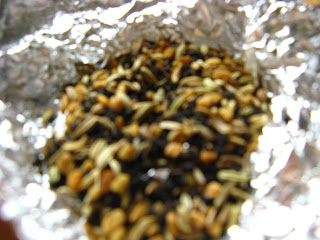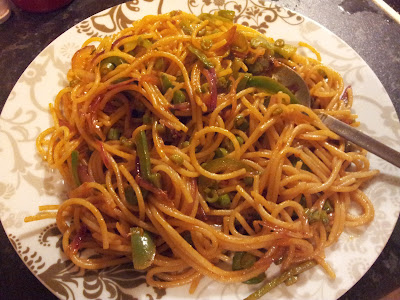Vegetable Rice (Pulao)
Well sorry for the terribly bad pic, but I was hungry :)
However I must admit that this is the easiest, fastest cooking and filling vegetarian dish. Cooked across India in almost every household. This is more than often also considered as food for the not so rich people in India. Nonetheless you will find vegetable pulao in the costliest restaurant with various add-ons, and a wonderful taste.
Hope you enjoy making and eating this dish as much as I do.
Ingredients:
1 bowl basmati rice
1 onion (medium size) shredded into long threads
2 tomatoes (medium size) cut into long pieces
3-4 medium sized potatoes cut into 8 pieces each
1/4 of cauliflower cut into medium sized pieces
1 Indian Bay Leaf - Large
Cooking Oil - 3 table spoons
Cumin Seeds (Zeera) - 2 tea spoons
Turmeric - 2 tea spoons
Dry coriander powder - 4 tea spoons
Red Chilli Powder - 3 tea spoons
Salt - 5 tea spoons or to taste
Water
For the final touch
Ghee - 2 table spoons
Ginger - 2 table spoons of long thin threads
Garlic - 1.5 table spoon of thin slices
Fresh coriander finely chopped
Method:
Soak rice in water and keep aside for 15 min.
Take cooking oil in a Pressure Cooker and heat it. When the oil is hot, add cumin seeds. Then add onions and stir fry till they are golden brown. Now add tomatoes, cauliflower and potatoes and mix well. Now add all the spices, and mix.
Now drain the water out of the rice, and add rice. Mix gently at this stage, as the rice can break if hit too hard. Add 1.5 bowl of water. Mix again.
Close the lid of the pressure cooker, and cook on high flame till you get two whistles. The moment you get two whistles, remove the cooker from the flame or hotplate, and let the steam take its time to release completely.
When done, open the pressure cooker and ensure rice is cooked.
Now take another pan and heat the ghee in it. Add the ginger, garlic and fresh coriander and heat for 1 min. Pour the mixture on top of the vegetable pulao and serve hot.
Tip: Served with coriander chutney, curd or raita and poppadums.





















